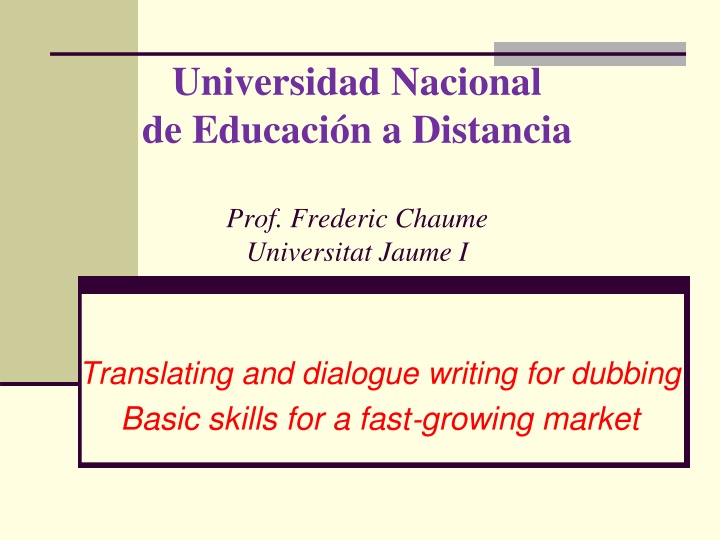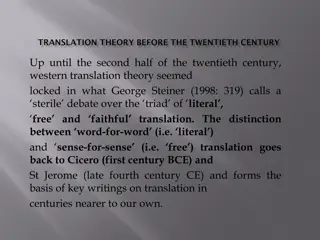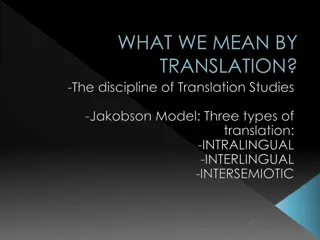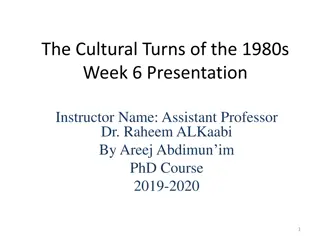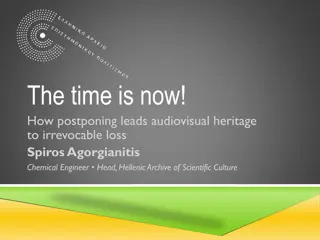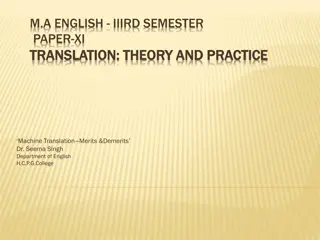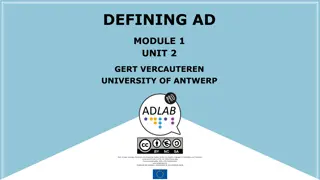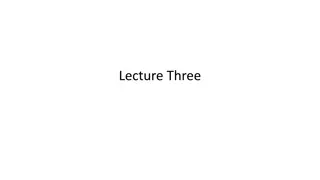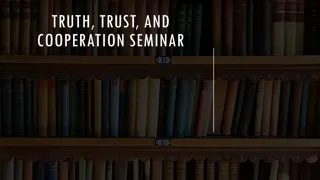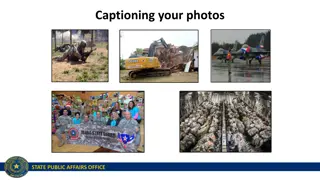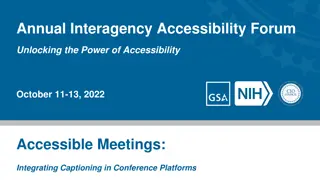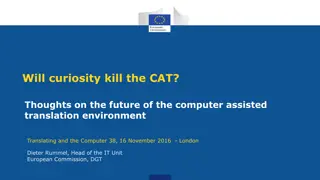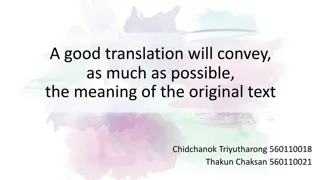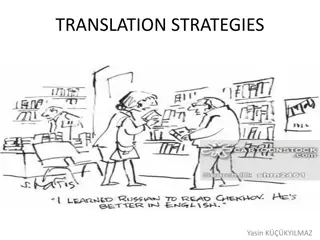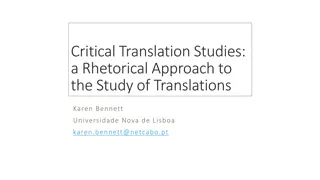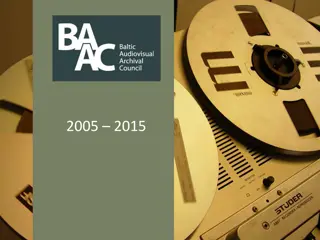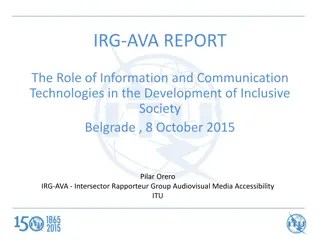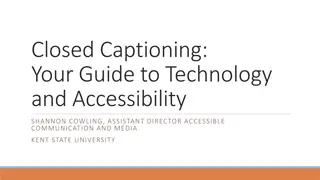Types of Audiovisual Translation: Revoicing and Captioning
Different types of audiovisual translation such as revoicing, dubbing, voice-over, subtitling, and more are explored in this comprehensive guide. The role of AVT in various settings like film festivals, advertising, and educational videos is highlighted, along with the importance of providing accessible content for the visually impaired and hard of hearing. The landscape of dubbing and AVT modes in Europe is also discussed, showcasing the growing market and demand for skilled translators in this field.
Download Presentation

Please find below an Image/Link to download the presentation.
The content on the website is provided AS IS for your information and personal use only. It may not be sold, licensed, or shared on other websites without obtaining consent from the author.If you encounter any issues during the download, it is possible that the publisher has removed the file from their server.
You are allowed to download the files provided on this website for personal or commercial use, subject to the condition that they are used lawfully. All files are the property of their respective owners.
The content on the website is provided AS IS for your information and personal use only. It may not be sold, licensed, or shared on other websites without obtaining consent from the author.
E N D
Presentation Transcript
Universidad Nacional de Educaci n a Distancia Prof. Frederic Chaume Universitat Jaume I Translating and dialogue writing for dubbing Basic skills for a fast growing market
TYPES OF AUDIOVISUAL TRANSLATION Spoken output (SL) > Written output (TL) Subtitling AVT Spoken output (SL) > Spoken output (TL) Revoicing
Types of AVT: Revoicing The original soundtrack is totally replaced by a new one in the TL and the target viewer can no longer hear the original exchanges Revoicing - Lip synch dubbing - Voice-over - Interpreting - Free commentary (es, de, en) The translation is overlapped and the original spoken dialogue is still audible in the background D az Cintas and Orero (2010: 41)
1. AUDIOVISUAL TRANSLATION TYPES: REVOICING AND CAPTIONING dubbing voice-over (including Polish narration and Russian dubbing/partial dubbing /Goblin Translation domesticating voice-over) simultaneous interpreting (film festivals, vee-jays) free-commentary audio description for the blind and visually-impaired (AD) audiosubtitling ______________________________________________ subtitling (+ surtitling + live subtitling) subtitling for the deaf and the hard-of-hearing (SDH) ________________________________________ New genres, formats and AVT Types videogames (dubbing + subtitling + localization) fansubs, fandubs, webtoons advertising, infomercials (dubbing, 2, subtitling, voice-over, new ads) instructional videos, webinars, corporate videos (voice-over)
The dubbing landscape Where is dubbing predominant?
AVT modes on cinema screens in Europe http://mediadeskpoland.eu/upload/PP_Comite_media_280708_FINAL.pdf
AVT modes on TV in Europe http://mediadeskpoland.eu/upload/PP_Comite_media_280708_FINAL.pdf
Europe o Changing landscape o Greece: TV series and soap operas are dubbed o Norway and Denmark: some teen pics are being dubbed o Russia: incorporating dubbing o Poland: incorporating subtitling in cinemas o Dubbing countries: MTV is introducing voice- over into fiction programmes
THE MARKET - Dubbing companies work for: TV stations Cable and digital broadcasting channels DVD, Blue-Ray Cinema Film festivals Film clubs How many products are dubbed? In house vs. foreign production Exercise 1: -Carry out an Internet search. Find at least 3 dubbing/recording studios in your country. - Check if the studios you found are included in the list of dubbing and subtitling companies provided at www.trama.uji.es Source: Chaume (2012)
OPENINGS AND JOB OPPORTUNITIES civil servants in public TV stations in-house translators (employees) in dub/sub companies and freelance translators access to the market: find dub/sub companies addresses (TV, DVD, etc.) set up a personal interview + submit CV there make a translation exam/proof you re service providers: offer direct and reverse translation, with or without script
Professional issues Academic and professional associations that run projects/organize activities that are relevant to AVT: AIDAC Associazione Italiana Dialoghisti Adattatori Cinetelevisivi (Italy) ATAA Association des Traducteurs/Adaptateurs de l'Audiovisuel (France) ATAA's Facebook Page ATRAE Asociaci n de Traducci n y Adaptaci n Audiovisual de Espa a AVTE Audiovisual Translators Europe BZO Beroepsvereniging van Zelfstandige Ondertitelaars (Netherlands) DHAP Dru tvo Hrvatskih Audiovizualnih Prevoditelja (Croatia) ESIST European Association for Studies of Screen Translation ESIST's Facebook page European Society for Translation Studies FIT (F d ration Internationale des Traducteurs Audiovisual Translation Committee FBO Forum for Billedmedieovers ttere (Denmark) IATIS International Association for Translation and Intercultural Studies NAViO Norsk Audiovisuell Oversetterforenings (Norway) STAW Stowarzyszenie T umaczy Audiowizualnych (Poland) STAW's Facebook Page SUBTLE Subtitlers for Excellence (UK) Suomen Av-k nt jien Sivustolle (Finland)
RATES IN SPAIN Translation // Dialog Writing Films/TV series 36,50 /reel (10 ) 40,00 /reel (10 ) Cartoons 34,75 /reel (10 ) 37,00 /reel (10 ) Documentaries 42,00 /reel (10 ) 15,75 /reel (10 ) Without Script and ReverseTranslation: + 100% Dubbing actors (voice talents) 25-30 /conv. + 3 /take France: price per dialogue line (TV) / per 20 reel (cinema)
The dubbing process Producer (International Agents ) Distributor TV Channel / Exhibitor Dubbing Studio (Casting and Production) TV Channel / Cinema House Source: Chaume (2004)
The dubbing process from the translators point of view Dubbing Studio (Casting and Production) Translator (Rough translation) Rough translation Dialogue Writer/ Adapter (Synchronised translation) Synchronised translation Dubbing Studio (Dubbing actors, director, etc. ) Adapters are responsible for synchronising the translation with the audio and visual cues of the original. Should translators be responsible for dialogue writing? Source: Chaume (2012)
The translators task Receives: script + FTP (DVD) Uses: Computer, access to the Internet, general & specialised dictionaries, various translation resources Submits: Word file with the translation sent by e- mail (+script, + DVD, + a printed version of the translation). Translation + Dialogue writing Occasionally: specific software to separate takes or to count actors and takes Source: Chaume (2012)
SCRIPTS AND DIALOGUE LISTS Documentaries (complete script) BEYOND 2000 - SERIES 6/90 - PROGRAM 012 - INTERNATIONAL NO. 182 1 SHOT NO. VISION (LENGTH OF SHOT) 1. BILLBOARD NICOTINE PATCH. (18.20) SOUND MUSIC (1) BEGINS OPENING TIMING 1.30.00 IAIN FINLAY (V/O) Is there an easy way to give up smoking? AT 1.38.00: Can the one in ten of us who will die from smoking related diseases be saved? 1.34.00 WIPE 2. BILLBOARD SNAKE TRACKER. (6.05) 1.48.20 1.49.20 IAIN (V/O) What did I do to deserve this story. Couldn't someone else have done it? WIPE 3. 1.55.00 BILLBOARD DIAMOND FILM. (8.20) Ad who will win the race to mass produce diamonds? Find out on Beyond 2000. 4. OPENING SEQUENCE. (16.07) TITLE - BEYOND 2000 (1.23) DISSOLVE 6. EL IAIN WALKS ACROSS STUDIO. (3.00) MUSIC CHANGE (2) Theme 2.06.00 2.03.20 5. 2.20.02 2.22.00 Prof. Frederic Chaume. Universitat Jaume I - Imperial College London
THE TARGET TEXT 1. NARRATOR 03.52 From Tarifa, in the South of the Iberian Peninsula, to Cabo Creus, up in the North, the Mediterranean Sea is a symbol of our identity and a source of richness. But above all, the Mediterranean Sea has a deep sentimental feeling for those who live next to it. ________________________________________________________ 2. 04.13 NARRATOR Along the Mediterranean shores we can find the roots of several civilizations that have settled in these lands. We have been enjoying one of the most wonderful climates of the planet since our ancestors settled here. __________________________________________________________ Prof. Frederic Chaume. Universitat Jaume I - Imperial College London
DIALOGUE WRITING: LAYOUT (I) GENERAL TRENDS Respect to the audiovisual narrative conventions as far as possible Scene changes (not shot changes) Action breaks Turning points One character leaves or comes into scene Audiovisual Punctuation Marks: Flash backs, flash forwards Iris, wipes, etc.
The target text layout (France) Street Soccer Episode 19-Trop d amour tue l amour / Hot Stuff ---- T leimages Kids ___________________________________________________ Boucle : 1 de 10:00:00:00 10:00:58:22 Dur e: 00:00:58:22 ___________________________________________________ Akim : (reac) Mr. Salim : Now watch... : Watch carefully... Albert the b : Oooooh! : Never seen anything like it! Ali : (reac) Mr. Salim : And that s nothing! Wait till you see what s next! : Watch... : what he s going to do! : And now he s going to make a super fast pass! Ali : (reac) The Scorpion : ( Yeah! Yeah! We re awesome! ) Mr. Salim : See, I told you! Albert the b : hhh! : I think the blues don t have a chance... : against... Mr. Salim : (mm__ Albert the b : against that! Mr. Salim : __end) Albert the b : So they are prepared! __________________________________________________ Boucle : 2 de 10:00:59:10 10:00:59:23 Dur e: 00:00:00:13 Prof. Frederic Chaume. Universitat Jaume I University College London
The target text layout (Germany) ER --- Emergency Room. Episode 247 ________________________________________________________________ 023 KOVAC: (OFF/ON) Sam! SAM: (OFF/ON) Wir fahren noch mal zu Shelley s, (.) zur Union Station (.), zum Park... KOVAC: ( ber.) Sam! (..) Sam, der Wagen steht... ___________________________________________________________________ 028 SAM: KOVAC: (OFF/ON) Er weiss mit seiner Krankheit umzugehen und, dass er viel trinken muss. ___________________________________________________________________ (Laute) 036 MORRIS: (Laut) Die Tagenschicht (..) (Kuss) (Laut) Ist das Leben nicht herrlich? JANE: (Laute) ___________________________________________________________________ Universitat Jaume I University College London Prof. Frederic Chaume.
The target text layout (Italy) Cuore d Africa 5 Ep. 4 ____________________________________________________________________________ 00:35 ALICE FC) Conter fino a tre. / (IC) Danny! / (DS) Sei pronto? DANNY (da CL) Scusa s , pronto. ALICE Okay? / (da FC) Uno / due / tre! CHARLOTTE (da FC) Corri, Ngozi, corri! (FIN. FC) DANNY (01:09) (FC) Fila dentro. / (IC) (fiato) ____________________________________________________________________________ 01:13 ALICE (da FC) Allora (fiato) che ne pensi? DANNY (da FC) Comincia a funzionare CHARLOTTE Possiamo liberarlo adesso? ALICE No, se non torna il proprietario. CHARLOTTE E allora che facciamo? ALICE Aah, potresti andare dai fornitori con Danny, va bene? (FIN. FC) DANNY No lei non pu . / (FC) Ci vado con Dup. ALICE (su muto) Ma, c spazio per tutti e tre no? DANNY (fiato) Forse un altra volta. / (FC) Sai una cosa? / (IC) Ti porto all asta degli animali la prossima settimana. (FIN. FC) ALICE (FC) (verso) CHARLOTTE (verso) ___________________________________________________________________________ 01:43 Prof. Frederic Chaume. Universitat Jaume I University College London 106 107 108
United States of America Loop # TCR Character ENGLISH GERMAN 1 1:00:50 EARL Oh God. God grant me the serenity to accept the things I cannot change Gott, gib mir die Gelanssenheit, Dinge hinzunehmen, die ich nicht ndern kann. 2 1:00:55 MARSHALL Why do you fight it so hard, Earl? Warum k mpfst so hart dagegen an, Earl? 3 1:00:58 EARL Courage to change the things I can Den Mut, Dinge zu ndern, di ich ndern kann. 4 1:01:01 MARSHALL Come on. You ve been a good boy for a long time You know you wanna do this Komm schon. Du warst lange Zeit ein gutter Junge. Du weisst, dass du das machen willst.
DIALOGUE WRITING: SYMBOLS (II) GENERAL TRENDS (OFF) Off screen dialogues (ON) On screen dialogues (by default) (G) Paralinguistic signs / SIMPLE PAUSE // DOUBLE PAUSE
DIALOGUE WRITING: LAYOUT (II) B) SYMBOLS (Spain) Depend on conventions in each company (OFF) Voice Off, Out of Camera (ON) On Screen, Field (DE) The character shows his/her back to the camera (DL) The character is far from the camera (SB) The character is on screen, but we can t see his/her mouth (G) Paralinguistic gestures (A la vez) Two or more characters speak at a time (P) (T) (X) A character interrupts another character (AMBIENTE) General shot pans - No dialogues in the script but a translation is offered (R) Laughter (LL) (PL) The character cries or weeps / Short Pause (2 -5 ) // Long Pause (6 -14 ) Prof. Frederic Chaume. Universitat Jaume I University College London
DIALOGUE WRITING C) SYNCHRONIZATIONOR LIP-SYNC Three types of synchronization: phonetic or lip synchrony: only close-ups, big/extreme close-ups and detailed shots (lips) (p,b,m,f,v + open vowels: a, e, o) kinetic synchrony or body movement synchrony: translation has to be coherent with movements isochrony or synchrony between utterances and pauses (German: texten; French: adapter) clips Prof. Frederic Chaume. Universitat Jaume I University College London
DIALOGUE WRITING D) ORAL SPEECH: dubbese Prof. Frederic Chaume. Universitat Jaume I University College London The creation of a convincing script, ideally meeting all the demands of the different types of synchrony, yet still creating the illusion of original dialog. Unlabored dialogs, avoiding artificiality But never real oral speech, it must comply with the standard norms (phonetics, morphology, syntax): written ____________________________X__________+ Translation routines: Pavesi, Ba os, Marz , Chaume, Prats, Romero, Bruti, Freddi, Matamala, Izard, Santamaria, Kozloff, Quaglio, Valde n, Valentini... spoken
